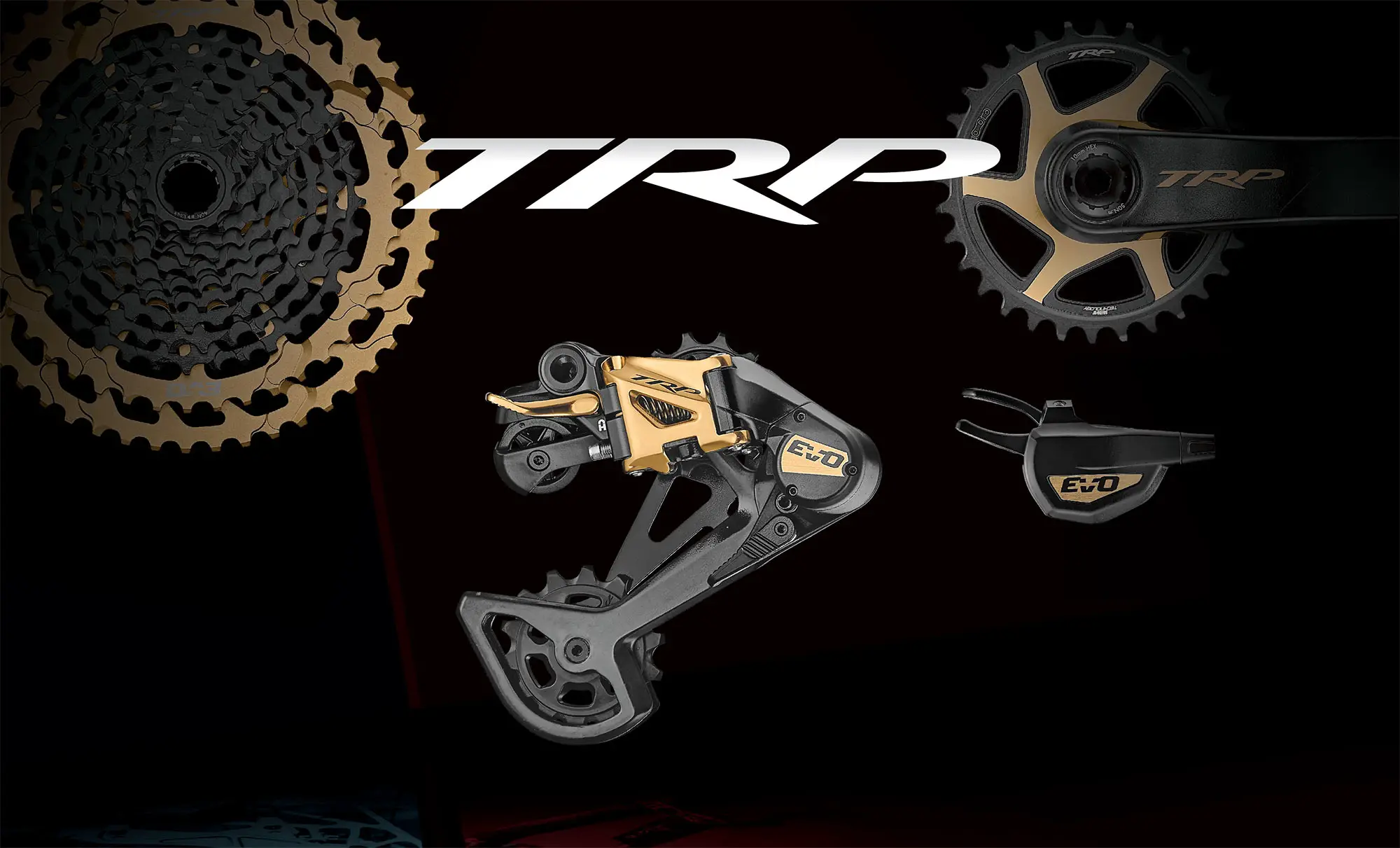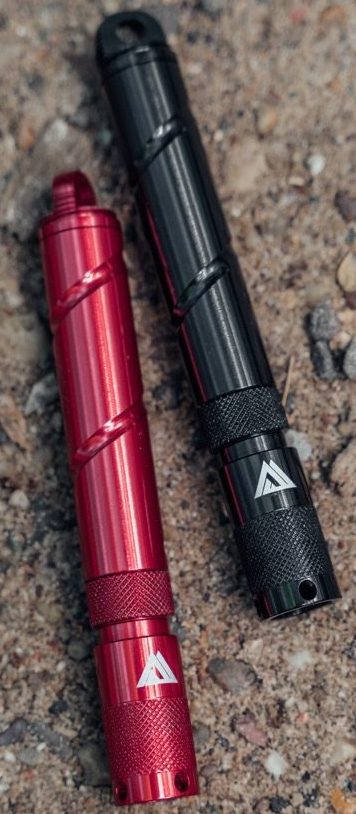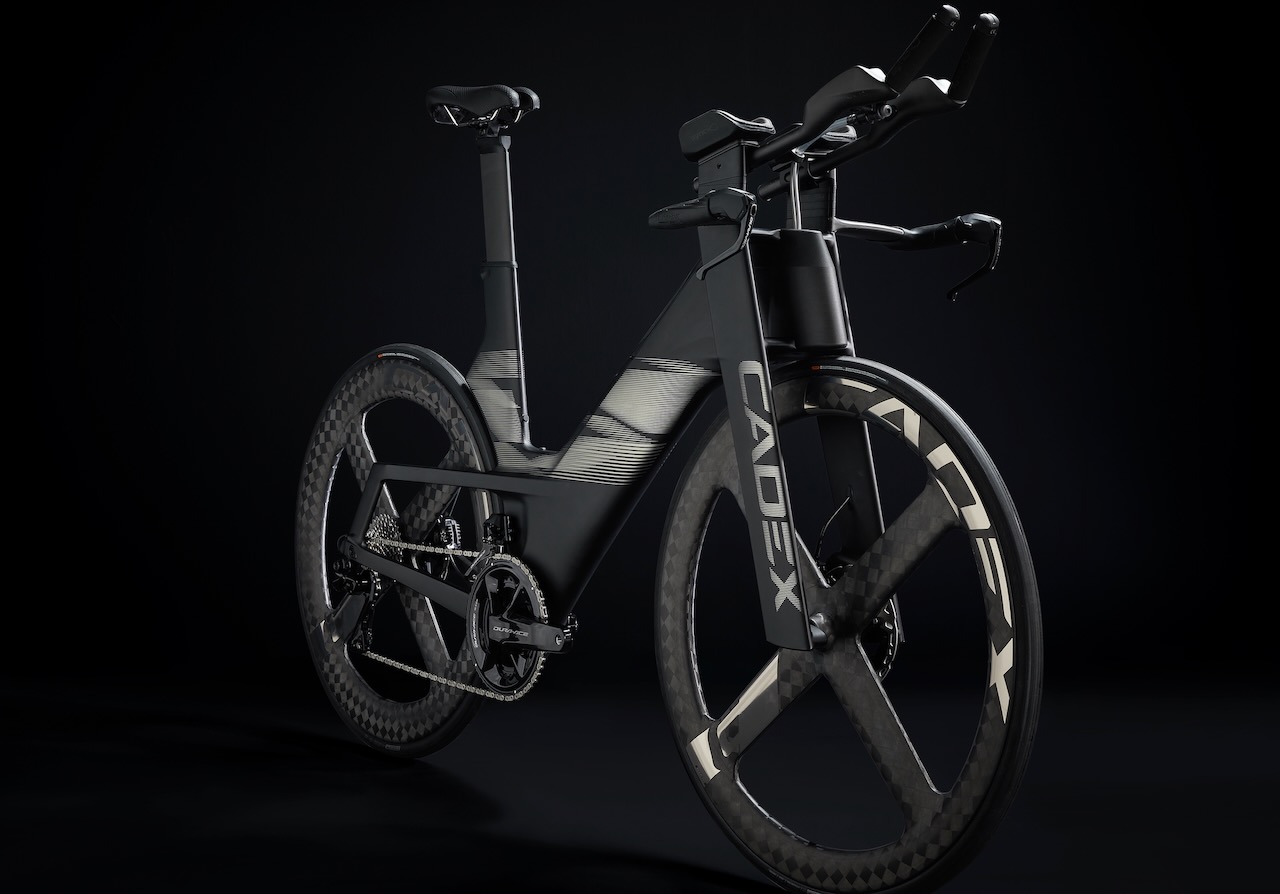[ad_1]
Technically a sneak peek of a new group that’s launching in April, I was invited to Taiwan to see the all-new TRP EVO MTB groups and give them a test ride.
The new EVO7 and EVO12 groups are 7-speed for DH and 12-speed for everything else, respectively, and are an evolution of the first-generation drivetrains launched a few years back. The TR12 was first spotted in May 2020, about six months after the TR7 debuted after testing under Aaron Gwin.
Those groups were, well, OK, but their performance was subject to how nicely they could play with 3rd party cassettes, chains, etc. Meaning, there was room for improvement by designing a complete drivetrain. And, if you’re going to do that, why not update everything to make it even better?
Introducing the all-new TRP EVO groups
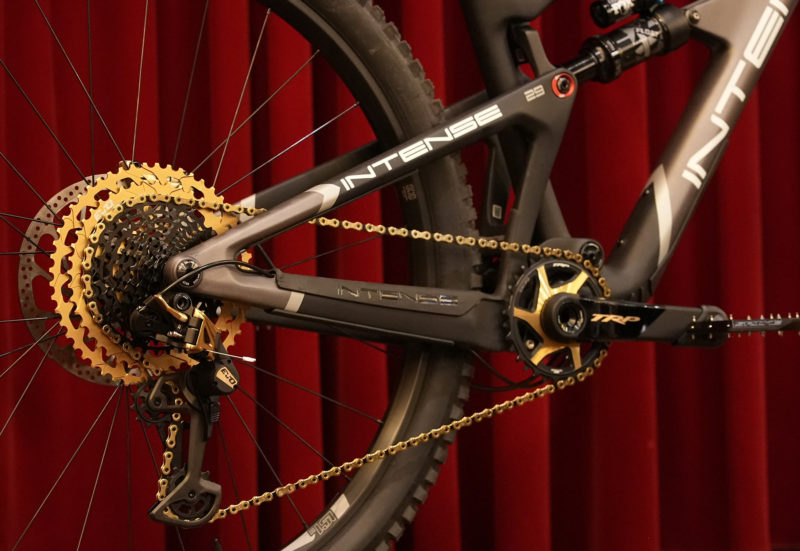
But first, some quick background…skip ahead to the next subtitle if you just want to see the parts and tech.
One of TRP’s guiding principles is “Match opportunities with your capabilities”. Well, TRP is known for their brakes, so, why develop a Drivetrain?
Because OEM placement has increasingly become homogenous, pairing complete drivetrains with brakes from the same brand. And they already have a lot of acceptance as OEM placement on a lot of bikes with their brakes, to the tune of 13 million brakes per year (that’s ~20,000 per day!) and employing 1,600 people globally.

In 2016, they signed Aaron Gwin with an aggressive sponsorship deal that gave him carte blanc to help design a brake. It worked, putting them on the World Cup map (and podiums).
Around that same time, they hired 50 engineers and researchers to develop their drivetrain program. After navigating a minefield of 15,000+ patents and being granted 130 of their own, they had a product.
They launched in 2019 with their first-gen 7-speed and 12-speed TRP-level derailleurs and shifters for mountain bikers. But, behind the scenes, they also started delivering 8/9-speed Tektro-level OEM groups in 2021, and now have 10/11-speed groups for OEM spec on lower-level bikes.
The distinction is important, because Tektro is the main brand, built on selling millions of brakes per year for entry- and mid-level bikes covering almost every category except road. TRP is the high performance division, making the brakes the pros are winning gravity races with.
You probably haven’t ridden or seen a Tektro or TRP drivetrain yet. But while they’ve been racking up WC DH wins with their TRP brakes, they’ve also been testing their drivetrains on the pro circuit and building their OE customer base for them.
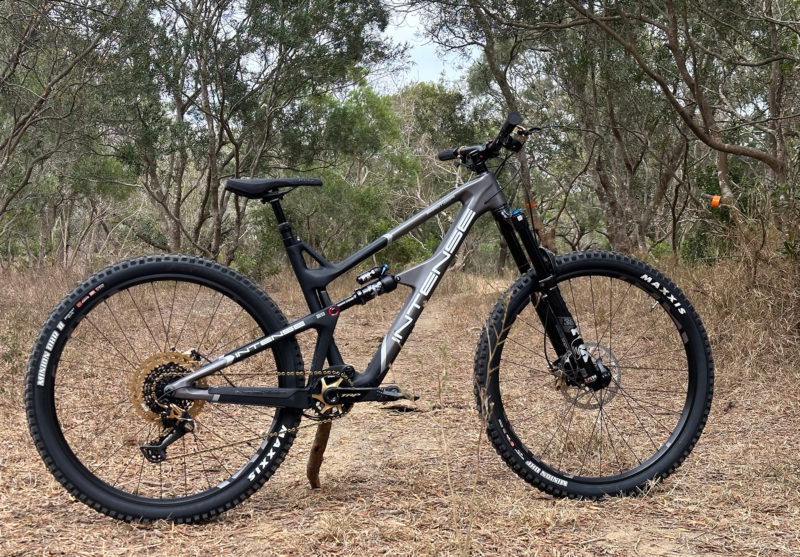
Now, in 2023, they’re replacing the TR12 bits with EVO12 as the second-gen enduro mountain bike drivetrain. Unlike the first round, this time it’s a complete group, offering cranks, chainring, and cassette.
And they’re starting at the top, positioning EVO12 at the XO/XTR Trail level. Because if you’re looking to capture hearts and minds, it’s best to create a premium product. It’s much harder to launch with a budget group and then convince us all that they can do a premium group, right?
TRP EVO Tech Features
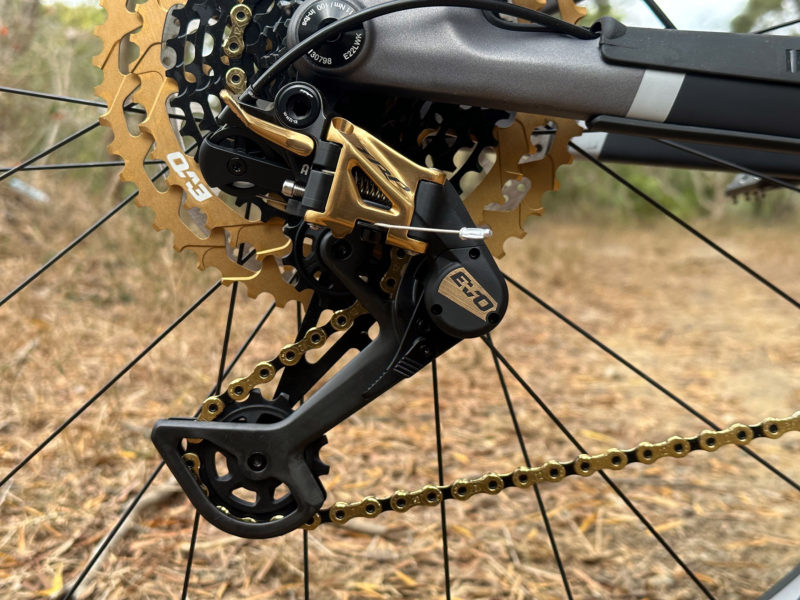
The new EVO12 derailleur makes a lot of improvements over the original TR12 parts, and introduces some new features.
The derailleur body itself is stiffer, and the parallelogram actuation is now linear (versus moving at a slant). The connecting pins are stronger, too. Combined, these give it more precise actuation.
Cable entry around the rear guide wheel is shorter and more direct. It’s worth pausing to appreciate that they’ve developed a high-end MECHANICAL group. While the industry seems hell-bent on making everything electronic and mostly wireless, there are a lot of reasons why a lot of folks may want a really good mechanical group, and now they have another option.

The most unique is the Hall Lock, named after Gwin’s mechanic John Hall. Essentially a band clamp that closes down around the mounting bolt, the Hall Lock steadies the derailleur body, preventing it from bouncing around and exacerbating chain slap.
Open it up to remove the wheel, otherwise, keep it locked.
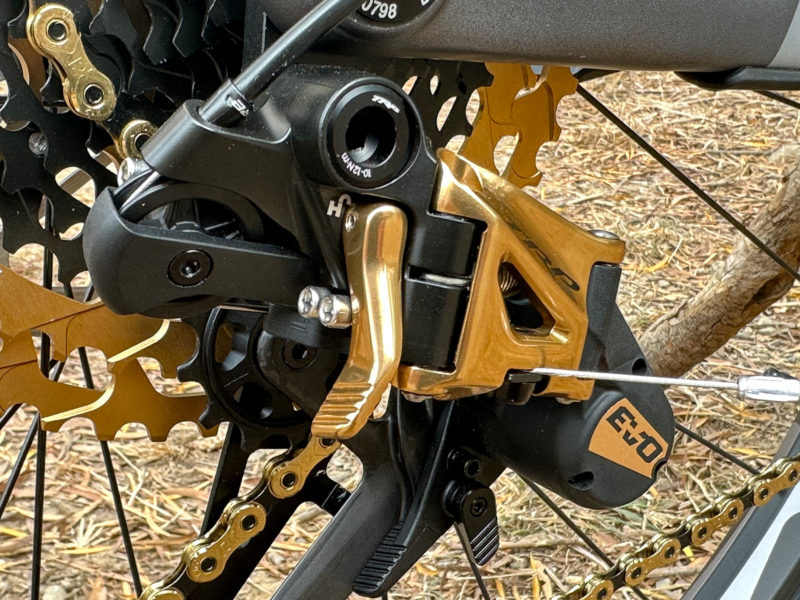
The clutch switches from a ratcheting mechanism to a silent clutch with one-way bearing pressed against a friction plate. It’s a 30% lighter clutch, so it’s easier to shift but still has the necessary cable management.
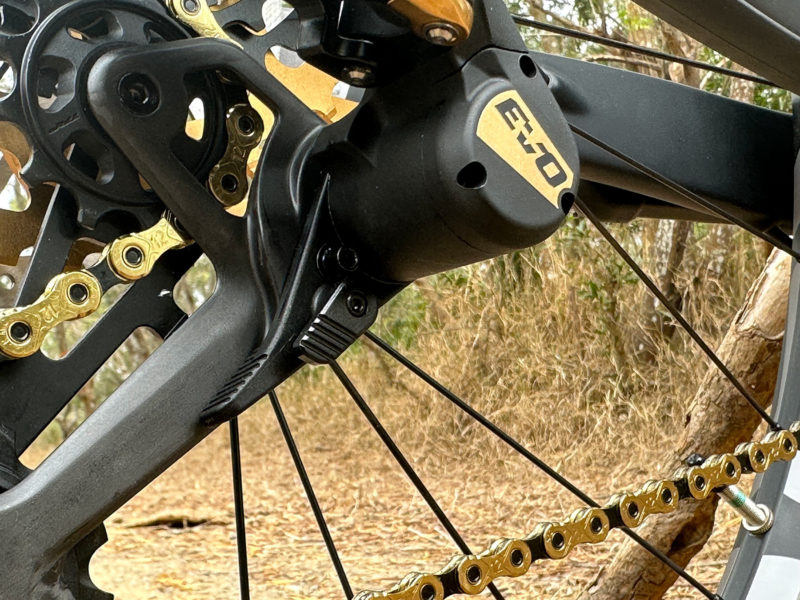
The Cage Release lever releases the tension spring from the pulley cage, letting it hang freely for wheel swaps. The bigger lever makes it easier to reconnect the cage back with the spring.

Lastly, the pulley cage gets a carbon fiber outer plate, and the 12/14-tooth pulleys get better mud evacuation channels to help it run cleaner.

The shifter gets a light lever action with a more compact design and reduced small parts inside for better durability.
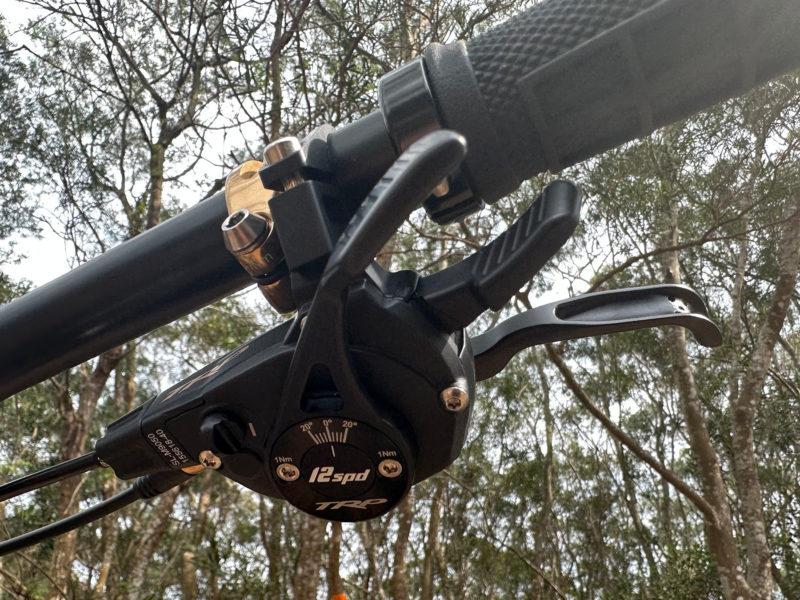
The downshift lever (goes to an easier gear) gets a new adjustment, letting you quickly switch from multi-shift to single-shift. Want to rip through 5 gears at once? Go for it. Prefer to count your clicks or put this on an e-MTB? Switch to single-click mode.
Sponsored EWS (now EDR) pro Cody Kelley says he prefers the single-click mode for racing because on really rough terrain, there’s no chance of accidentally shifting too many gears, so it helps him keep focused and avoid mistakes. He’s been running the group for a while and has been providing feedback throughout their development process.
Cable routing is streamlined and parallel to the bar, which is going to be really good for the coming wave of mountain bikes with full internal cable routing.

The cassette was one of the more challenging parts of the drivetrain. They went through at least 15 iterations during testing, but the effort seems to have been worth it. Gearing is 10-11-13-15-18-21-24-28-32-36-44-52.

It’s a two-piece construction that comes in 1g lighter than XX1 and 2g lighter than XTR (their claims). The lower 10 cogs are machined from a single piece of steel, and the upper two out of 7075 aluminum.
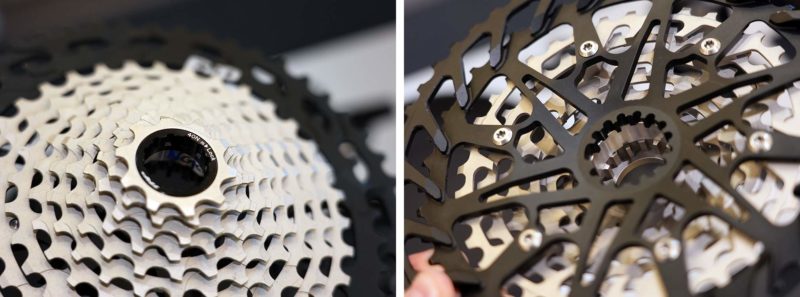
It mounts to a Shimano Microspline freehub body because it’s a more accessible standard. If you look at non-SRAM cassettes that fit on the XD body, they require a convoluted mounting design to work around SRAM’s patents. That’s not the case with Microspline, so you can mount it directly to the FH body and give it a more stable design.
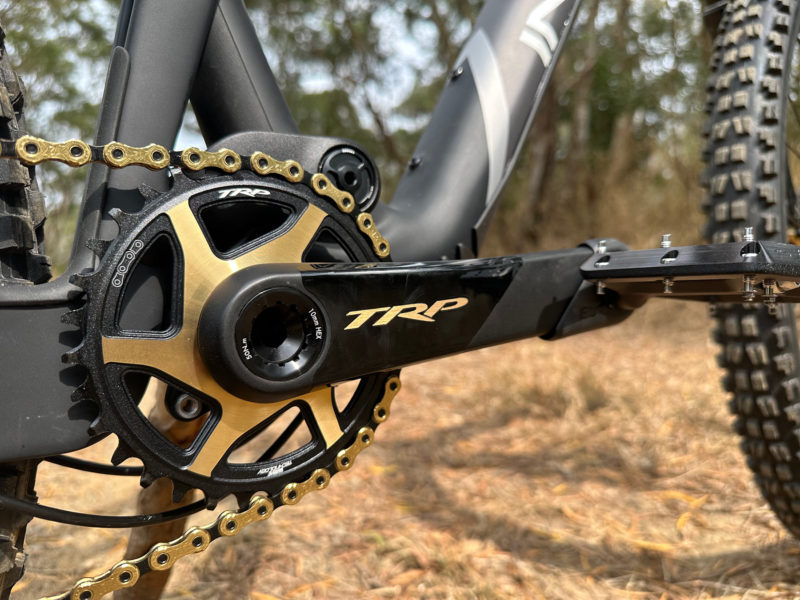
So far, everything you’ve seen is made by TRP in their own factories. This include the cranks, both carbon and alloy versions. They say this gives them far better quality control, and they even make the chainrings but are licensing MRP’s Wave tooth pattern rather than deal with “narrow wide” patent issues.
The only part of the group they don’t make is the chain, spec’ing KMC X12 chains and optimized the cassette and everything else around that.
Another note: Because so many bikes have adopted the SRAM UDH standard, they’ve essentially standardized derailleur and axle/end cap placement, which benefits every group, not just the new Transmission stuff. Combine that with Microspline’s tight tolerance spec and TRP can offer a system that requires minimal B-gap adjustment to dial in shifting performance.
TRP EVO Pricing, Weights & More
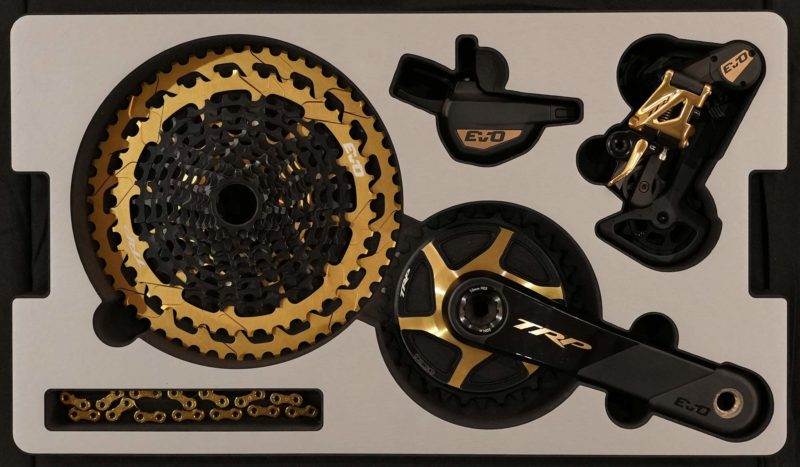
The EVO12 group will come in Gold and Silver finishes. Functionally the same, it’s just cosmetic. Pricing and claimed weights for EVO12 parts are:
- Crankset – Carbon: $350 – 504g (170mm)
- Crankset – Alloy: $150 – (TBD)
- Chainrings – $75-$80 – 81g (Boost 32T)
- Bottom Bracket – $42 – (TBD)
- Cassette: $399 – 372g
- Chain: $39 (silver), $75 (gold) – 270g
- Shifter: $100 (silver), $110 (gold) – 125g (w/o clamp or cable)
- Derailleur: $230 (silver), $240 (gold) – 301g


The EVO7 DH group comes in black for most parts, but the shifter and derailleur can have the gold finish, too. It gets a 165mm alloy crank, no carbon option.
- Crankset – Alloy: $150
- Chainrings – $75
- Cassette: $100
- Shifter: $100 (silver), $110 (gold)
- Derailleur: $230 (silver), $240 (gold)
Beyond things like branding and market acceptance, the other critical part of getting widespread OEM placement and adoption is ensuring global support. From parts warehousing and delivery to customer service, any product looking for placement on complete bikes sold globally needs to be able to quickly deliver replacements and repair parts. TRP has this, and they’re expanding it more with the launch of the drivetrains.
[ad_2]
Source link

